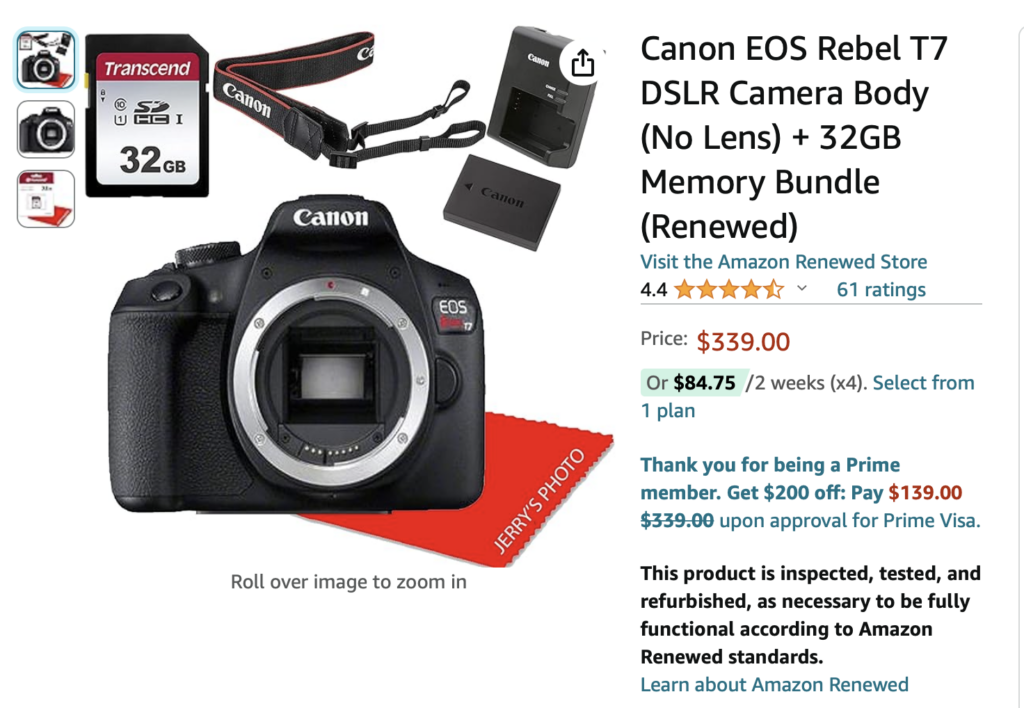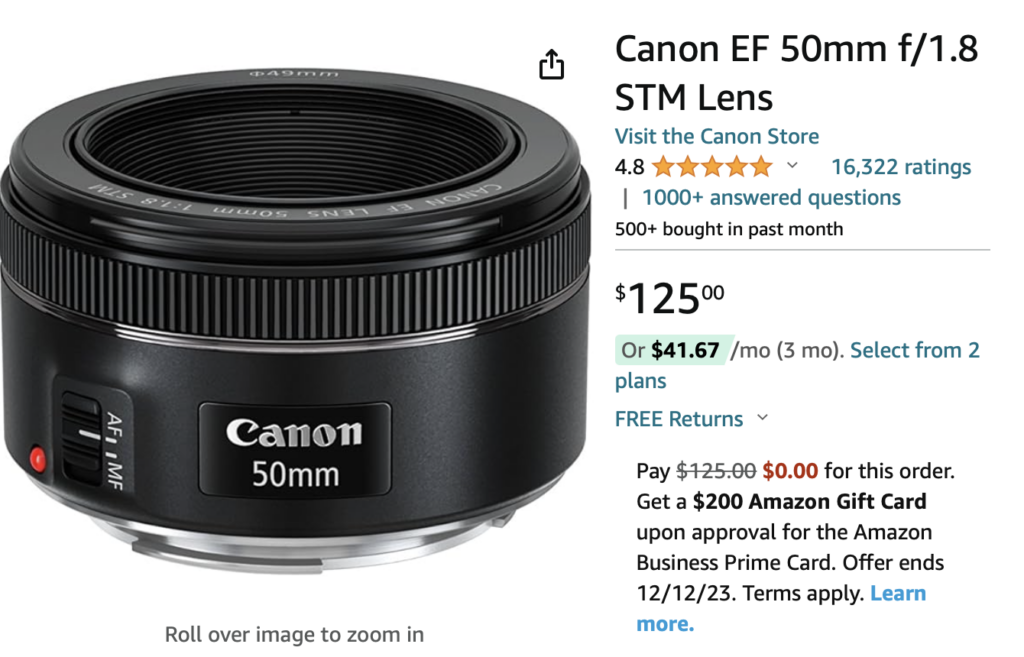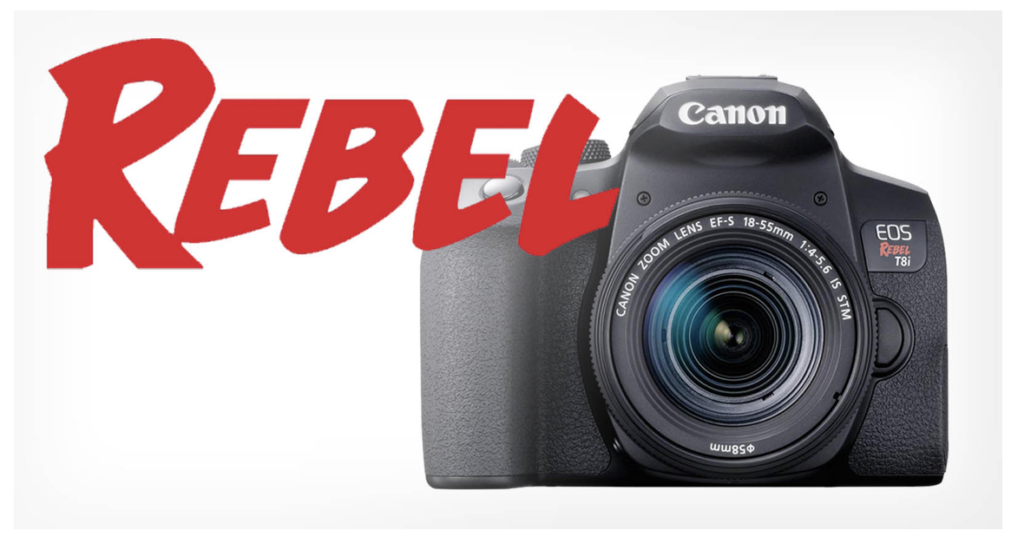Every Christmastime I get a few people who ask me what to buy for someone who is interested in photography.
Whether it be themselves or a family member they want to know the best place to start.
I get it. Photography is a big world and there are SO many opinions and ideas out there for all price points and types of photography.
I am going to share what worked for me. <3
Here is a quick Gift Guide: (for a more thorough breakdown keep reading)
Starter/Intro Camera: Canon Rebel (any model, I suggest buying second hand)
Try offerup or ask a photographer friend if they know anyone who has one they’re not using that they are wiling to sell.

Starter Lens: EF 50mm 1.8F
EF is the Lens Series that fits the Canon Rebel I believe they are still the same but do a quick search on Canon.com to check your model as most lenses are not returnable. It should be around $125 and you can get them at Best Buy or Online.

Other Supplies: 1 Extra Battery Pack, a Protective Camera bag, An Expo-Disc and a 1TB Solid State Harddrive
Batteries for Canon Rebel:
Most Camera batteries you can find off brand very cheap but I prefer to buy from canon.com directly or someone who sells canon batteries as using third party brands can affect your camera and void the warranty. Not worth the risk for me but you can make that choice yourself.
The bags I love and use are out of business now. 🙁 But you can sometimes find them used. Search “Kelly Moore Bag” I use the Scout the most.

EXPO DISC: Only buy expo disc brand or the color may be off. TIP:
Get a larger than all your lenses size and use it for all instead of getting one for each lens.
I am a professional portrait and wedding photographer. But when I started I thought I wanted to be exclusively a newborn photographer… or maybe a landscape photographer..or no, I think I want to do real estate photography…actually product photos because I need those for my business.
You get the idea. I had no idea what I wanted to do. And as someone who felt late to the game, as it seemed like all these photographers I met came out of the womb with a camera in hand, I felt an extra pressure to ‘catch up’.
A pressure that propelled me forward in technique and skill but a pressure that almost got me spending more money than I had to spend on all this.
My approach to getting into photography is very… what you might call DAVE RAMSEY.
A MORE THOROUGH BREAKDOWN…
CAMERAS:

My first camera was given to me by my aunt. A 15 year old Canon Rebel.
I Highly suggest the Canon Rebel as a starter camera.
Canon is a sturdy brand that you can depend on to stick around. This is great for several reasons.
- The interface and menus will be easier to learn when you stick with one brand and eventually upgrade your camera
- The supplies and repair skills are more easily available than other smaller brands
- Camera equipment is an investment. It is not like a phone where you buy the new model every time it comes out. It’s extremely expensive and if you invest in a brand that goes under or stops selling the lenses, batteries etc that accompany the camera you have you will have spent a lot of money on equipment you can no longer use.
Nikon is also a great brand. I don’t have any reason for not choosing Nikon besides a piece of advice my very first photography instructor gave me.
He said if a friend uses Canon get Canon, if they use Nikon get Nikon. This will allow you to share equipment in case of an emergency (you drop a lens, camera is malfunctioning, need an extra flash…)
MORE ABOUT THE CANON REBEL:
The Canon Rebel is an affordable starter camera because it is a crop-sensor: Essentially without getting too technical this means it crops in and doesn’t pick up as much informations so it cost less. This is also what keeps it from being a true full-frame Professional Camera.
Rebels are DSLRs which means Digital Single Lens Reflex. AKA it has a Mirror in it that reflects light, captures and image and then records it digitally.
I have and use THIS DSLR for back up but prefer my new Mirrorless Canon line because the sensor of the camera can get dirty and affect quality.
The reason I bring this up is I presume there are lots of tech-y YouTube videos out there telling you to ONLY get mirrorless and it’s the way of the future etc.
While I agree this is a starter camera and mirrorless will only add to the cost.
Who knows maybe canon is working on a mirrorless intro-level camera as we speak.
Features of the Rebel that you need, to learn photography:
-Lenses and Lens capability (we will talk about this in the next section)
-Manual Control of Aperture, Shutter Speed and ISO (This is essential to learning professional photography and if you don’t have control of theses 3 things you are essentially just using a glorified smartphone camera)
-Custom or Kelvin White Balance Control (optional and the model I started with did not have Kelvin options only Custom. We can talk about grey cards etc later on in other camera equipment).
LENSES:
Please don’t buy kit lenses (any lens that comes in a new starter ‘kit’ alongside a camera).
Just buy the camera with no kit lens and then buy this:
(If you did choose to go with Nikon you have the option of a 35mm or a 50mm but Canon does not make a 35mm for crop-sensor cameras if I am remembering correctly)
This is the perfect lens for beginner photography because it is the closest you can get to the vision of your natural eye. It’s a great place to start.
It also has low aperture capabilities meaning it can let MORE light in than kit lenses. Which is what you need in a beginner camera to make the quality presentable without having great quality of ISO.
Long story short this makes grain in your photos when it’s dark outside. Take for example a photo on your phone taken at night without flash and a friends camera also taken without flash. Which one has more grain (little dots that make it unclear) THAT is the one with lower ISO capabilities.
Aperture or F-Stop is another way to let light in and also adds something called Bokeh to photos (a blurry background) without compromising the quality of the image so having a LOWER number before the F is always better in my opinion.
Other photographers argue you never need a lower F-stop than 2.8F but I rarely shoot above it. If you know how to focus and you like a blurry background there is no better options than a prime lens with a low number in front of that F.
THIS IS MY FAVORITE LENS I use it exclusively for portrait sessions, and for weddings it is my work horse.

As you can see the 50mm 1.8F is an amazing affordable intro option for prime lenses in comparison.
Now that you have your intro camera and intro lens lets talk about some other equipment you might need.
I am a photography minimalist. I like to say I am a photographer, not a photography gear collector.
I encourage all beginning photographers to not get sucked up into the photography gear collector game. Remember that the gear does not make the photographer.
Thinking a photographer is more or less the value of the camera that they own is not a good judgment of skill.
This would be like assuming someone can bake well because of the price of their oven. Maybe it correlates but not always.
You definitely wouldn’t assume someone was a bad baker because they had an older, modest, worn oven. You would try their treats! That’s how you would really know.
Rather than collecting equipment to add seeming value to your resume I suggest starting a blog or instagram account showing off your work so people can see what you do.
I have never once on a wedding day had a bride ask me how expensive my lens was.
All that being said here are a few things I think would help the learning process.
PHOTOGRAPHY GEAR:
-A Good Protective Bag. I use Kelly Moore Bags because they are sturdy and durable and very protective but when I first started I just had a backpack I got off of Amazon that I used until it fell apart.
if you are interested in hiking, hunting and landscape photography I love my Badlands Camera Bag.
If you are traveling with a camera I suggest Pellicase for extra protection on planes and boats.
– An Expo Disc: I like to buy these used on OfferUp from people who never learned how to use them. Haha. They are magical and the only Grey-Card Type of device that I use or suggest.
Learning White Balance is something a lot of photographers push to the back burner but I suggest learning it right along side your exposure triangle as it has a huge influence over image quality for a lower quality camera.
-An Extra Battery: It’s always smart to have a fully charged extra battery on hand especially if you are being paid for the photos you are taking
-A reliable SD Card. I use THESE Sandisk 30GB cards. I prefer to use a lower GB card because if there is an issue error of flaw it will not affect as many images but often you have to search to find them lower than 64GB.
I use Sandisk Extreme or Extreme Pro but the Ultra ones are fine too.
Lastly you’ll need a good external hard drive so you don’t bog down your compute with huge image files. I don’t have any specific suggestions I have used lots of kinds I like. The one requirement I always have is just that it is solid state so it doesn’t get destroyed by dropping it! I usually look for 1 TB for info and that lasts a few years (although I replace sooner now just to be safe for my clients). I usually just buy what is on sale at Costco around Christmas time.
leave a comment